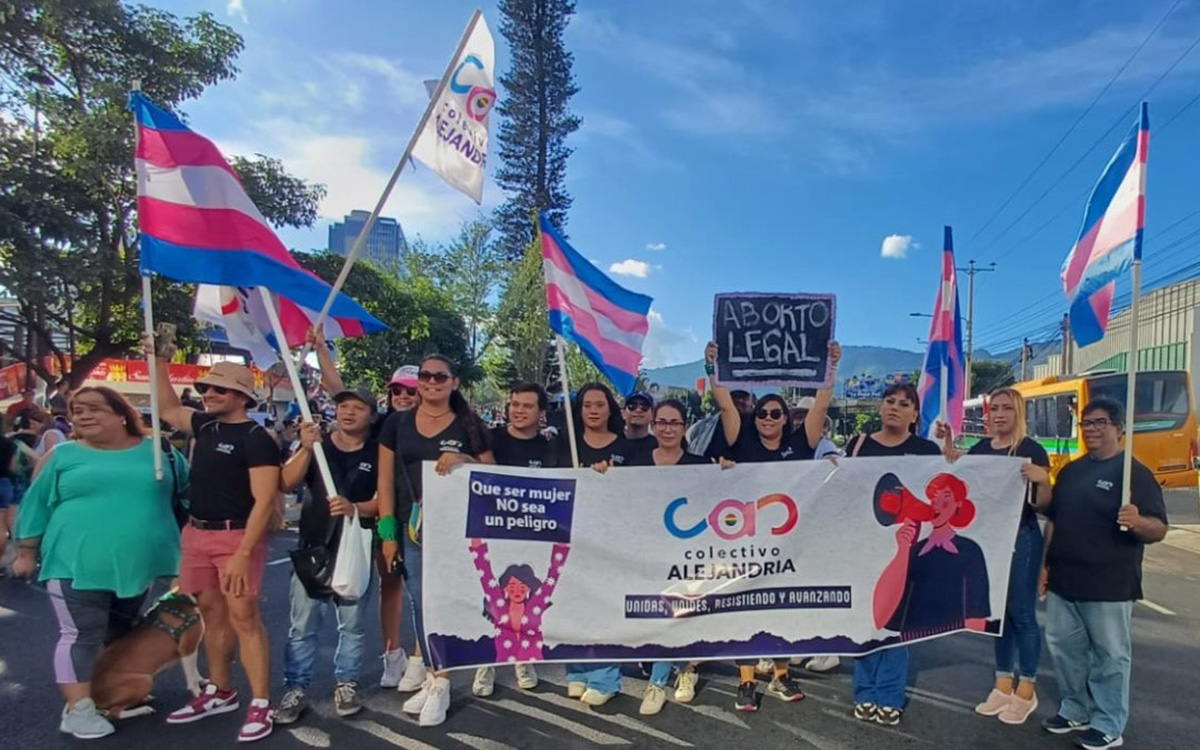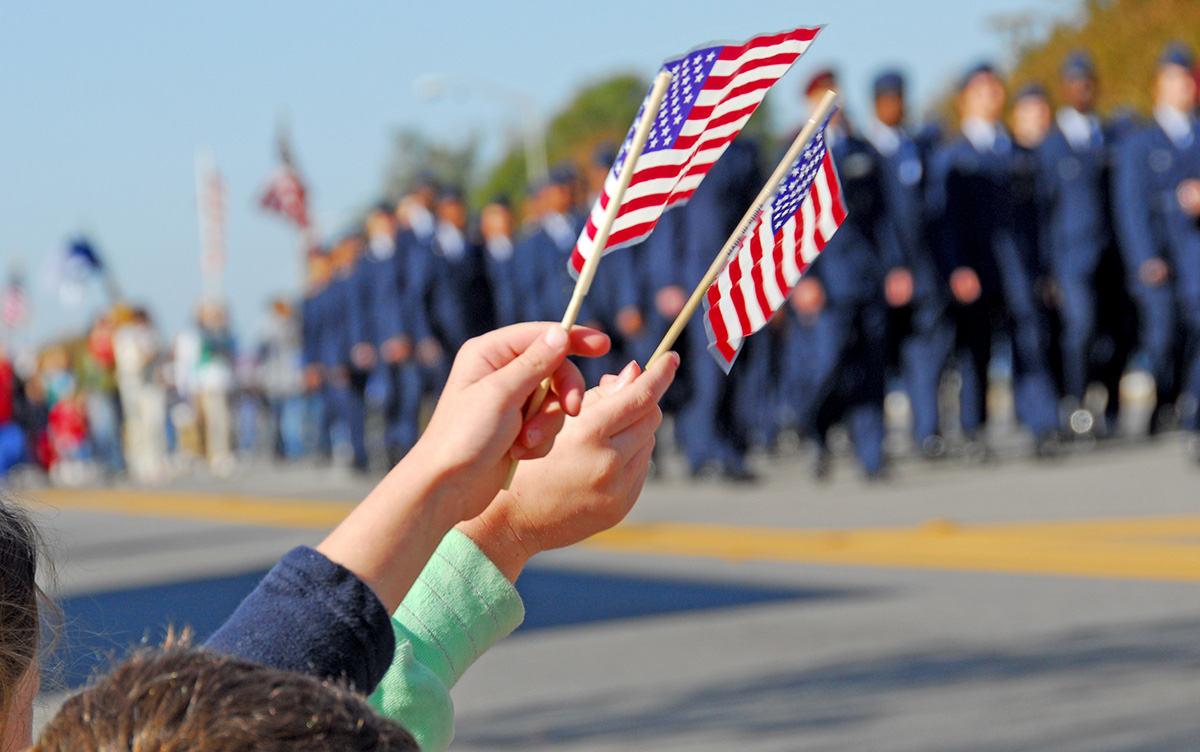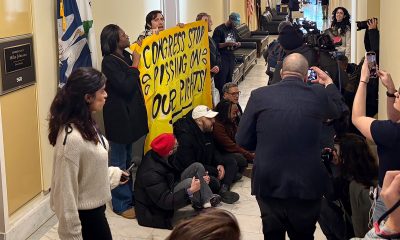Opinions
Media must address growing crisis of anti-LGBTQ violence
Mainstream outlets ignoring plight of trans people of color


Kenne McFadden (Photo courtesy of Facebook)
Alphonza “Peaches” Watson’s mom called her “the sunshine of our family.” In her mom’s words, she was “a very caring, passionate, fun person to be around, always in a talkative and playful mood.” Alphonza was a black, transgender woman, and in March 2017, she was shot in the stomach and killed.
Kenne McFadden liked to post videos of herself singing on Facebook and was called the “friendliest person ever” who could “be assertive when the time came” by one of her friends. In April 2017, her body was found floating in the San Antonio River. Kenne’s killer admitted to pushing her into the river and repeatedly misgendered her in his confession — but on March 8, a judge ruled that he will not be tried for her death. LGBTQ advocates are now calling for justice, because like Alphonza, Kenne was also a trans woman of color.
Alphonza’s and Kenne’s deaths were two in a staggering 22 reported hate violence-related killings in 2017 of transgender women of color, who are disproportionately the victims of anti-LGBTQ violence. According to a January report by the National Coalition of Anti-Violence Programs, there were at least 52 reported hate violence-related homicides of LGBTQ people last year. That’s an 86 percent increase from 2016, nearly double the number. But if you get your news from national TV news, you probably haven’t heard the victims’ names or heard reports about the growing trend of violence that has scourged the LGBTQ community.
Media Matters analyzed broadcast and cable TV coverage of anti-LGBTQ violence in 2017, and what we found was simply unacceptable. Even though 2017 saw the fifth consecutive annual increase in anti-LGBTQ hate violence, cable and broadcast TV news spent a total of less than 40 minutes covering this disturbing growing trend. Sometimes coverage didn’t even mention the LGBTQ identities of the victims, and it rarely featured voices from the queer community. What’s worse, more than half of the coverage was about just two individual cases, and those reports largely failed to connect these individual cases to the larger trend of anti-LGBTQ violence.
These deaths are not occurring in a vacuum, and they’re not isolated incidents. This is an epidemic, and it’s not showing signs of slowing down. This year already, at least six trans women have been killed in the United States alone. In January, a 19-year-old gay University of Pennsylvania student named Blaze Bernstein was allegedly murdered by a neo-Nazi associated with an extremist group that has been increasingly responsible for violence and whose racist ideology is growing in the U.S. There were four times as many gay men killed in 2017 as in 2016.
It’s no coincidence that violence is increasing at the same time that the Trump administration has prioritized eroding the humanity of LGBTQ people. Anti-LGBTQ hate groups like Alliance Defending Freedom (ADF) have unprecedented influence over policy at every level. With the help of ADF, the Trump administration has issued a guidance policy that makes it easier for people and businesses to discriminate against LGBTQ people, and ADF has worked tirelessly against transgender student equality in schools. In fact, it doesn’t seem like there is any part of LGBTQ life that opponents of equality won’t go after, from adoption rights to prison policy. And now, for the first time in years, an annual report on attitudes toward LGBTQ people has found that straight adults are less likely to accept them. The full-out assault against LGBTQ people is trickling down from the top.
The media have a distinct role to play in talking about the depths of this problem, which is, quite literally, a life and death issue for the LGBTQ community. The fight for queer, and particularly trans, equality did not end with marriage, and LGBTQ people are increasingly becoming targets of violence amid an ever-growing movement to dismantle our rights. Trans women of color have been attacked just for walking down the street. Gay men have been lured to their deaths on dating apps. One man, Juan Javier Cruz, was shot and killed after he defended his friends from homophobic slurs and threats. TV news helps set the agenda for public discourse, and policy and cultural changes that can protect this community cannot happen without an informed public. The media have a responsibility to inform this community and our allies that our rights — and, in fact, lives — are at stake. And connecting the dots between vicious rhetoric and policies and the actual safety risks LGBTQ people face could show those in the middle, or even our opponents, that there are consequences to such vitriol.
And when TV news does cover anti-LGBTQ, and particularly anti-trans, violence, it’s crucial that it provide context about this epidemic. We found that less than a third of the segments discussing anti-LGBTQ violence drew a line from individual cases to the growing trend, with the rest of the coverage completely failing to contextualize the cases as anything other than isolated incidents. This community is a target, and victims’ identities should not just be an afterthought.
Additionally, TV news should work to include LGBTQ voices, particularly trans voices, in coverage. When MSNBC hosted a panel of transgender guests to talk about the Trump administration’s attacks on their rights, the guests used personal experiences to connect the dots between administration policies and rhetoric and the increased violence facing the community.
We owe it to Alphonza Watson, to Kenne McFadden, to Juan Javier Cruz — and to the 49 other members of the LGBTQ community killed in 2017 simply for being who they were — to say their names and tell their stories. The media has a job to do to help keep the rest of the LGBTQ community and its allies safe and informed. Covering their stories, and the environment that led to their deaths, isn’t just a matter of honoring their lives; it is what we must do to save others.
Brennan Suen is LGBTQ program director for Media Matters For America.

I hope you have a great Thanksgiving and can enjoy it with family and friends and that you have things you can be thankful for this past year. That you have your health. Now here is the column I would have liked to share with you this Thanksgiving:
To all my friends and family. This year I am thankful the felon has left the White House. It feels we can all finally breath again. I am so happy his idea of a ballroom at the White House was a joke, and we can once again walk in Jackie Kennedy’s rose garden, and visit the beautiful East Wing. I am thankful the felon’s personal Goebbels, Stephen Miller, lost his job when the reality that he was a fascist was too much to take. It was wonderful to see the Supreme Court wake up and do their job once again. They stopped drinking the MAGA Kool-Aid and voided all the executive orders calling on museums to hide the history of Black Americans, women, and the LGBTQ community. They told the president he didn’t have the right to place tariffs, and that he couldn’t fire legally appointed members of commissions under the rubric of Congress’s control.
Then I am thankful the Congress began to do its job. That so many Republicans grew a set of balls and decided to challenge Speaker Mike ‘sycophant’ Johnson, reminding him they were an independent part of government, and didn’t need to rubber stamp everything the felon wanted. I was thankful to see them extend the SNAP program indefinitely, and the same with the tax credits for the ACA, agreeing to include these important programs in next year’s budget. Then they went further, and paid for the programs, by rescinding all the tax benefits they had given to the wealthy, and corporations, in the felon’s big ugly bill. Finally realizing it is the poor and middle class who they had to help if the country was to move forward. Then I can’t thank them enough for finally passing the Equality Act, and doing it with a veto proof majority, so the felon had to sign it, before he left office. They did the same for the Choice Act, and the Voting Rights Act. It was a glorious year with so much to be thankful for.
Then I am so thankful Congress finally stood up to the felon and said he couldn’t start wars without their approval, and the Supreme Court ruled they were right. That attacking Venezuela was not something he had the right to do. Then the final thing the court did this year I am thankful for, is they actually modified their ruling on presidential immunity, and said the felon’s grifting was not covered, as under their decision that was private, and not done in his role as president. Again, can’t thank them enough for waking up and doing that.
Then there is even more I am thankful for this year. It was so nice to see Tesla collapse, and Musk lose his trillion-dollar salary. The people finally woke up to him and insisted Congress mandate the satellite system he built, basically with money from the government, was actually owned by the government, and he could no longer control who can use it. It was determined he alone would not be able to tell Ukraine whether or not they can use it in their war defending against the Russian invasion. Then I am so thankful Congress went even further, and approved the funds needed by the Ukrainians for long-range missiles, and a missile defense system, accepting Ukraine was actually fighting a proxy war for the West, and Ukraine winning that war would help keep our own men and women off the battlefield.
And speaking of our military, I thank Congress for lifting the ban on transgender persons in the military, and honoring their service, along with the service of women, Black service members, all members of the LGBTQ community, and all minorities. It was fun to see Pete Hegseth being led out of the Pentagon, and being reminded he wasn’t the Secretary of War. There is no Department of War, it is still the Department of Defense, with congressional oversight. Again, so many things to be thankful for this past year. It seemed like my heart runneth over.
Then my alarm went off and I woke up from my big beautiful dream, only to realize I was still living in the Trumpian nightmare.
Peter Rosenstein is a longtime LGBTQ rights and Democratic Party activist.
Commentary
Elusive safety: what new global data reveals about gender, violence, and erasure
Movements against gender equality, lack of human rights data contributing factors.

“My identity could be revealed, people can say whatever they want [online] without consequences. [Hormone replacement therapy] is illegal here so I’m just waiting to find a way to get out of here.”
-Anonymous respondent to the 2024 F&M Global Barometers LGBTQI+ Perception Index from Iraq, self-identified as a transgender woman and lesbian
As the campaign for 16 Days Against Gender-Based Violence begins, it is a reminder that gender-based violence (GBV) — both on– and offline — not only impacts women and girls but everyone who has been harmed or abused because of their gender or perceived gender. New research from the Franklin & Marshall (F&M) Global Barometers and its report A Growing Backlash: Quantifying the Experiences of LGBTQI+ People, 2022-2024 starkly show trends of declining safety among LGBTQI+ persons around the world.
This erosion of safety is accelerated by movements against gender equality and the disappearance of credible human rights data and reporting. The fight against GBV means understanding all people’s lived realities, including those of LGBTQI+ people, alongside the rights we continue to fight for.
We partnered together while at USAID and Franklin & Marshall College to expand the research and evidence base to better understand GBV against LGBTQI+ persons through the F&M Global Barometers. The collection of barometers tracks the legal rights and lived experiences of LGBTQI+ persons from 204 countries and territories from 2011 to the present. With more than a decade of data, it allows us to see how rights have progressed and receded as well as the gaps between legal protections and lived experiences of discrimination and violence.
This year’s data reveals alarming trends that highlight how fear and violence are, at its root, gendered phenomena that affect anyone who transgresses traditional gender norms.
LGBTQI+ people feel less safe
Nearly two-thirds of countries experienced a decline in their score on the F&M Global Barometers LGBTQI+ Perception Index (GBPI) from 2022-2024. This represents a five percent drop in global safety scores in just two years. With almost 70 percent of countries receiving an “F” grade on the GBPI, this suggests a global crisis in actual human rights protections for LGBTQI+ people.
Backsliding on LGBTQI+ human rights is happening everywhere, even in politically stable, established democracies with human rights protections for LGBTQI+ people. Countries in Western Europe and the Americas experienced the greatest negative GBPI score changes globally, 74 and 67 percent, respectively. Transgender people globally reported the highest likelihood of violence, while trans women and intersex people reported the highest levels of feeling very unsafe or unsafe simply because of who they are.
Taboo of gender equality
Before this current administration dismantled USAID, I helped create an LGBTQI+ inclusive whole-of-government strategy to prevent and respond to GBV that highlighted the unique forms of GBV against LGBTQI+ persons. This included so-called ‘corrective’ rape related to actual or perceived sexual orientation, gender identity, or expression” and so-called ‘conversion’ therapy practices that seek to change or suppress a person’s gender identity or expression, sexual orientation, or sex characteristics. These efforts helped connect the dots in understanding that LGBTQI+ violence is rooted in the same systems of inequality and power imbalances as the broader spectrum of GBV against women and girls.
Losing data and accountability
Data that helps better understand GBV against LGBTQI+ persons is also disappearing. Again, the dismantling of USAID meant a treasure trove of research and reports on LGBTQI+ rights have been lost. Earlier this year, the US Department of State removed LGBTQI+ reporting from its annual Human Rights Reports. These played a critical role in providing credible sources for civil society, researchers, and policymakers to track abuses and advocate for change.
If violence isn’t documented, it’s easier for governments to deny it even exists and harder for us to hold governments accountable. Yet when systems of accountability work, governments and civil society can utilize data in international forums like the UN Universal Periodic Review, the Convention on the Elimination of All Forms of Discrimination Against Women, and the Sustainable Development Goals to assess progress and compliance and call for governments to improve protections.
All may not be lost if other countries and donors fill the void by supporting independent data collection and reporting efforts like the F&M Global Barometers and other academic and civil society monitoring. Such efforts are essential to the fight against GBV: The data helps show that the path toward safety, equality, and justice is within our reach if we’re unafraid of truth and visibility of those most marginalized and impacted.
Jay Gilliam (he/him/his) was the Senior LGBTQI+ Coordinator at USAID and is a member of the Global Outreach Advisory Council of the F&M Global Barometers.
Susan Dicklitch-Nelson (she/her/hers) is the founder of the F&M Global Barometers and Professor of Government at Franklin & Marshall College.
Commentary
Second ‘lavender scare’ is harming our veterans. We know how to fix it
Out in National Security has built Trans Veterans State and Local Policy Toolkit

Seventy years after the first “lavender scare” drove LGBTQ Americans from public service, a second version is taking shape. Executive directives and administrative reviews have targeted transgender servicemembers and veterans, producing a new wave of quiet separations and lost benefits.
The policy language is technical, but the result is personal. Veterans who served honorably now face disrupted healthcare, delayed credentials, or housing barriers that no act of Congress ever required. Once again, Americans who met every standard of service are being told that their identity disqualifies them from stability.
Out in National Security built the Trans Veterans State and Local Policy Toolkit to change that. The toolkit gives state and local governments a practical path to repair harm through three measurable actions.
First, continuity of care. States can keep veterans covered by adopting presumptive Medicaid eligibility, aligning timelines with VA enrollment, and training providers in evidence-based gender-affirming care following the World Professional Association for Transgender Health Standards of Care Version 8.
Second, employment, and licensing. Governors and boards can recognize Department of Defense credentials, expedite licensing under existing reciprocity compacts, and ensure nondiscrimination in state veterans’ employment statutes.
Third, housing stability. States can designate transgender-veteran housing liaisons, expand voucher access, and enforce fair-housing protections that already exist in law.
Each step can be taken administratively within 90 days and requires no new federal legislation. The goal is straightforward: small, state-level reforms that yield rapid, measurable improvement in veterans’ daily lives.
The toolkit was introduced during a Veterans Week event hosted by the Center for American Progress, where federal and state leaders joined Out in National Security to highlight the first wave of state agencies adopting its recommendations. The discussion underscored how targeted, administrative reforms can strengthen veterans’ healthcare, employment, and housing outcomes without new legislation. Full materials and implementation resources are now available at outinnationalsecurity.org/public-policy/toolkit, developed in partnership with Minority Veterans of America, the Modern Military Association of America, SPARTA Pride, and the Human Rights Campaign.
These are technical fixes, but they carry moral weight. They reaffirm a basic democratic promise: service earns respect, not suspicion.
As a policy professional who has worked with veterans across the country, I see this moment as a test of civic integrity. The measure of a democracy is not only who it allows to serve but how it treats them afterward.
The second “lavender scare” will end when institutions at every level decide that inclusion is an obligation, not an exception. The toolkit offers a way to begin.
For more information or to access the toolkit once it is public, visit outinnationalsecurity.org/toolkit.
Lucas F. Schleusener is the CEO of Out in National Security.
-

 The White House5 days ago
The White House5 days agoTrans workers take White House to court over bathroom policy
-

 Congress4 days ago
Congress4 days agoMTG resigns after years of anti-LGBTQ attacks amid Trump feud
-

 U.S. Military/Pentagon5 days ago
U.S. Military/Pentagon5 days agoCoast Guard’s redefinition of hate symbols raises safety concerns for service members
-

 Local4 days ago
Local4 days agoComings & Goings


















